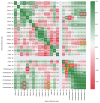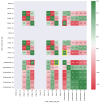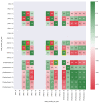COVID-WAREHOUSE: A Data Warehouse of Italian COVID-19, Pollution, and Climate Data
- PMID: 32756428
- PMCID: PMC7432400
- DOI: 10.3390/ijerph17155596
COVID-WAREHOUSE: A Data Warehouse of Italian COVID-19, Pollution, and Climate Data
Abstract
The management of the COVID-19 pandemic presents several unprecedented challenges in different fields, from medicine to biology, from public health to social science, that may benefit from computing methods able to integrate the increasing available COVID-19 and related data (e.g., pollution, demographics, climate, etc.). With the aim to face the COVID-19 data collection, harmonization and integration problems, we present the design and development of COVID-WAREHOUSE, a data warehouse that models, integrates and stores the COVID-19 data made available daily by the Italian Protezione Civile Department and several pollution and climate data made available by the Italian Regions. After an automatic ETL (Extraction, Transformation and Loading) step, COVID-19 cases, pollution measures and climate data, are integrated and organized using the Dimensional Fact Model, using two main dimensions: time and geographical location. COVID-WAREHOUSE supports OLAP (On-Line Analytical Processing) analysis, provides a heatmap visualizer, and allows easy extraction of selected data for further analysis. The proposed tool can be used in the context of Public Health to underline how the pandemic is spreading, with respect to time and geographical location, and to correlate the pandemic to pollution and climate data in a specific region. Moreover, public decision-makers could use the tool to discover combinations of pollution and climate conditions correlated to an increase of the pandemic, and thus, they could act in a consequent manner. Case studies based on data cubes built on data from Lombardia and Puglia regions are discussed. Our preliminary findings indicate that COVID-19 pandemic is significantly spread in regions characterized by high concentration of particulate in the air and the absence of rain and wind, as even stated in other works available in literature.
Keywords: Italian COVID-19 data; climate data; data analysis; data integration; data warehouse; pollution data.
Conflict of interest statement
The authors declare no conflict of interest.
Figures








References
-
- World Health Organization . World Health Organization: Coronavirus Disease 2019 (COVID-19) World Health Organization; Geneva, Switzerland: 2020. Situation Report, 88.
-
- Le T.T., Andreadakis Z., Kumar A., Roman R.G., Tollefsen S., Saville M., Mayhew S. The COVID-19 vaccine development landscape. Nat. Rev. Drug Discov. 2020;19:305–306. - PubMed
-
- Phua J., Weng L., Ling L., Egi M., Lim C.M., Divatia J.V., Shrestha B.R., Arabi Y.M., Ng J., Gomersall C.D., et al. Intensive care management of coronavirus disease 2019 (COVID-19): Challenges and recommendations. Lancet Respir. Med. 2020;8:506–517. doi: 10.1016/S2213-2600(20)30161-2. - DOI - PMC - PubMed
MeSH terms
LinkOut - more resources
Full Text Sources

